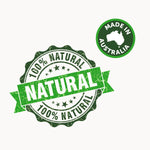
Transitioning A Puppy To Raw Food
With more and more people learning of a raw food diet for their pets, they are wanting to implement this type of species appropriate diet from the earliest of ages, ideally when they first bring their new puppy home!
This is great, but it raises a lot of NEW questions for new puppy owners.
What Age Puppies Wean Onto A Raw Diet?
Pups can begin to be weaned from their mum as young as 4 weeks old, but ideally 5-6 weeks of age is the best age to start introducing their new fresh food diet.
How Do I Transition My Puppy To A Raw Food Diet?
In an ideal scenario, the pups mum will also be on a raw, fresh food diet during pregnancy and lactation, as this will already be passing the diet onto her pups and will be easier to transition the pups. This may be something you could speak with the breed about prior to collecting your puppy.
When you decide to begin weaning, we suggest adding 1 new ingredient (listed below in order) to the existing diet every 3-4 days to give the pup chance to adjust to the new addition as well as you having time to see how they take to it.
- If they’re still feeding on mum, you don’t need to add a milk supplement, but if you do choose to or if they are no longer with mum but need milk, goats milk is the best choice as it is the most gentle on their tummy.
- Meat is the first solid ingredient to introduce. Make sure it is preservative, additive and sulfur dioxide free. Puppy mince in the form of raw chicken mince is ideal.
- Offal is the next step, but only up to 10% of the total daily intake should make up their diet. Any more and your pup will end up vomiting or with diarrhea.
- Soft bones and cartilage. Nothing too big or hard for little pups. Chicken necks or chicken wings are a good starter and are completely safe to feed raw, do not cook them! As they get a bit older, beef brisket bones are a great option too.
- For dogs (not cats), you can then introduce pulped vegetables. Most vegetables are safe to feed, just avoid the onion family. Pulping or grating finely is ideal too as the pup can digest these most effectively and get the vitamins and minerals from them well.
- If your pup is a food guzzler, a slow feeder dog bowl can help them to pace their eating which will also help to prevent reflux and bloating when transitioning their diet.
A Balanced And Complete Raw Diet
It is important to remember that when feeding a raw diet to your pet of any age, there is a delicate balance of vitamins and minerals that need to be included to ensure the diet in balanced and complete. If it’s not, your pet could develop deficiencies over time.
For example, feeding just raw meat on its own is not a sufficient diet for a pet and you would need to add supplements.
Skip processed dog treats when training your puppy and rather, opt for natural dog treats like dehydrated beef and small bones like lamb ribs.
How Much Do I Feed A Puppy?
Just like a pregnant or lactating pets, your pup or kitten has an increased food intake that grows with them. The general rule is to be giving a percentage of the pets body weight daily in food depending on the age.
For eg a 7-10 week old pup requires 10% of their bodyweight daily. If that pup weighs 5kg, that would equal 500g (split into appropriate amount of meals).
See our "Raw Feeding Guide” which lists all the percentages that need to be fed to growing pups. Or you can check out our dog food calculator to be sure you're feeding enough raw puppy food.
